"A Greener Kitchen" April 22, 2010 - Volume 2 - Issue 08
|
|
|
|
|
|
Degrees of Green
| In forty years of Earth Days, we've
learned a lot! Yet, our individual impact on the planet is one of those topics
where the more we know, the more we realize what we don't know! Whatever your
motivation for becoming greener in your lifestyle, the power of incremental
change can bring enormous benefits to you individually, and collectively to the
planet. Green  kitchen habits save energy, help maintain sustainable
environments, and can save money! kitchen habits save energy, help maintain sustainable
environments, and can save money!
Green isn't just trendy; it's smart
and thrifty! Doing things differently -- more green -- in the kitchen doesn't
have to affect quality, nor decrease enjoyment. In this issue, we pick a
few of our favorite "green" tips for cooking and cleaning green. We demonstrate
some of these green tricks right away in three easy, appetizing
recipes.
|
APRIL Special
|

|
|
|
|
No Pain, All Gain -- Trimming the Kitchen Footprint
| 
|
Green Cleaning
| 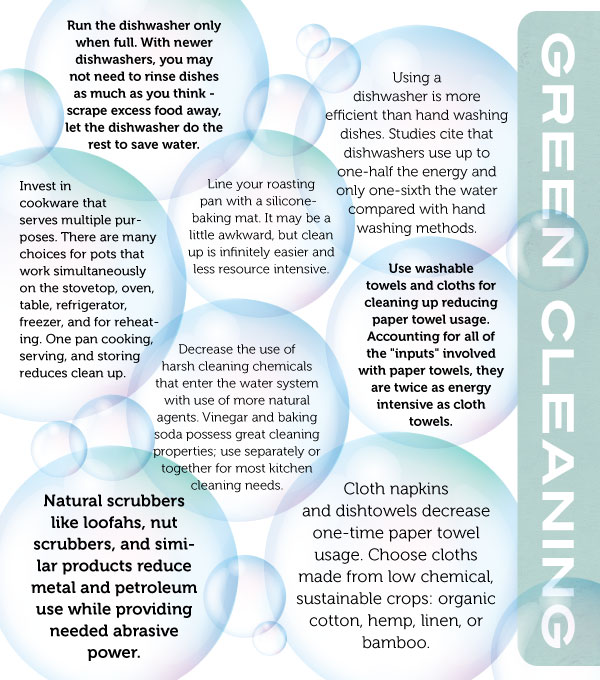
|
Reduce, Reuse, Repurpose, and Recycle
|
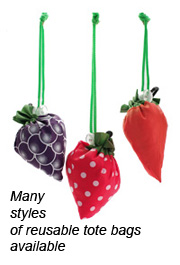 During our
lifetimes, each of us will produce about 45 tons of garbage. That's a
staggering quantity of "stuff" discarded. With a little effort, the
amount of "stuff" we use can be reduced, reused, repurposed, or
recycled. During our
lifetimes, each of us will produce about 45 tons of garbage. That's a
staggering quantity of "stuff" discarded. With a little effort, the
amount of "stuff" we use can be reduced, reused, repurposed, or
recycled.
Reduce
- Buy less packaging, put several produce items in one produce
bag, buy loose fruit and vegetables in usable quantities instead of
prepackaged units. Buy in bulk, then refill containers.
Reuse - Carry reusable tote bags to the market and all
shopping stops; keep compact nylon bags in your purse or glove
compartment.
Repurpose - Some food packaging can be
used again, e.g., today's empty bread bag, carries tomorrow's sandwich
to work.
Recycle - Clean and separate food
packaging for local recycling.
 Composting- This
type of recycling is an easier habit that you might think. Plant-based
food scraps can be easily composted at home diverting valuable organic
material from landfills where the material will not be available for use
again. Keep a compost pail near the kitchen sink and add food scraps.
Compost pails are equipped with a charcoal filter in the lid to
eliminate any odors between emptyings. Compost pail contents may be Composting- This
type of recycling is an easier habit that you might think. Plant-based
food scraps can be easily composted at home diverting valuable organic
material from landfills where the material will not be available for use
again. Keep a compost pail near the kitchen sink and add food scraps.
Compost pails are equipped with a charcoal filter in the lid to
eliminate any odors between emptyings. Compost pail contents may be  dumped
outside in a compost pile or bin, or taken to a local compost recycling
location. The decomposed organic matter becomes rich dirt that yard
plants love. Here's a good link to a Beginner's Guide to composting. dumped
outside in a compost pile or bin, or taken to a local compost recycling
location. The decomposed organic matter becomes rich dirt that yard
plants love. Here's a good link to a Beginner's Guide to composting.
What can be composted? -
Generally, any plant-based item can be composted. This includes any
fruit and vegetable trimmings, coffee grounds (including the paper filter),
and tea bags. With the exception of eggshells, animal-based foods, (meat,
fish, dairy, fats), do not make for good compost and should be placed in
the garbage. Most packaging is not compostable - tin cans, plastic
bags, or bottles.
|
Smart Refrigerator Tips
| Tip #1:
The refrigerator is the most energy-intensive appliance in a household
and can amount to 20% of a household's electric bill.
Tip #2: Keep your refrigerator set at
optimal temperatures, 39-40ºF, and your freezer at 0ºF. Any colder and
energy is wasted.
Tip #3: Fill
the refrigerator to 75% capacity even if it's just with water or sodas.
The chilled mass will help the refrigerator recover faster from door
openings and closings. (Too full, and chilled air circulation will be
uneven and impeded).
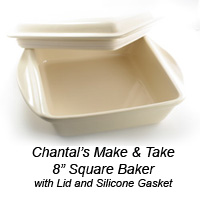
Tip #4:
Store leftovers in reusable containers with lids instead of using
plastic wrap or foil to cover. Chantal's "Make and Take" stoneware with its
natural glaze has a silicone gasket on the lid for secure storage.
Tip #5: Defrost frozen foods overnight
in the refrigerator capturing the cool energy to help power the
refrigerator. (It's also a good idea for food safety reasons to defrost
in the refrigerator).
Tip #6: Vacuum
the coils of the back of your refrigerator regularly for efficient
energy transfer.
Tip #7: Do
we need to say this? Don't stand with the refrigerator door open
mulling over your possible selections.
|
Q & A's
|
 Q: My slow cooker is "on" for hours each time it's used. Is this
energy
efficient? Q: My slow cooker is "on" for hours each time it's used. Is this
energy
efficient?
A:Newer
slow cookers are very energy efficient and even
though they are "on" for long periods, they use very little energy in
maintaining their low cooking temperatures. All-in-one meals made in a
slow cooker will maximize the energy usage.
 Q: Why should I
change from incandescent lighting to compact fluorescent lighting (CFL)? Q: Why should I
change from incandescent lighting to compact fluorescent lighting (CFL)?
A:Your kitchen may be the last
holdout for switching to CFL bulbs because of unique "spots" or
"floods." CFL's are now available in many of these unusual shapes and
sizes. Changing light bulbs is one of the simplest and most impactful
things we can do to conserve energy. About 90% of the energy used by an
incandescent bulb is given off as heat, not lighting! A CFL bulb uses
only 25% the amount of energy that an incandescent bulb does.
Q: What are micro-fiber cloths, and how do
they work?
A:Now
available are many micro-fiber products that can be used for most
cleaning tasks in the kitchen and throughout the house. Micro-fiber
cloths and a little water accomplish most cleaning tasks without any
chemical agents! Micro-fibers are a Swedish invention where microscopic
threads create a special surface that grabs and captures molecules of
dirt, grease, and even some germs. A micro-fiber cloth will last through
several hundred launderings. |
|
Cookbook Review
| Big Green Planet Cookbook by
Jackie Newgent, RD. Copyright 2009. Published by John Wiley & Sons,
Inc., Hoboken, NJ. Copyright 2009.
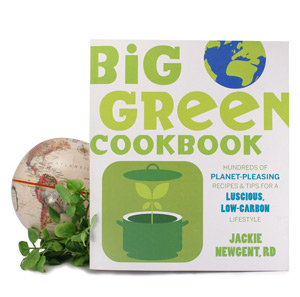 Cooking
consciousness is raised with a cookbook like the Big Green Cookbook. The author presents hundreds of delicious recipes and gently
guides us to greener cooking habits along the way. She begins her
mentoring with the structure of the book; recipes are grouped according
to the season. This organization helps us transform our farmer's market
trips in a purposeful direction with inspiration for the changing
bounty. The tutorial continues with plentiful tips and instruction in
each recipe's sidebars. We're taught about "lid cooking," serving in
"peels," and turning off the burner a minute or two early and allowing
residual heat to finish the task. Ms. Newgent brings an energy and humor
to her writing that is contagious and enabling in helping us shift our
cooking habits. Cooking
consciousness is raised with a cookbook like the Big Green Cookbook. The author presents hundreds of delicious recipes and gently
guides us to greener cooking habits along the way. She begins her
mentoring with the structure of the book; recipes are grouped according
to the season. This organization helps us transform our farmer's market
trips in a purposeful direction with inspiration for the changing
bounty. The tutorial continues with plentiful tips and instruction in
each recipe's sidebars. We're taught about "lid cooking," serving in
"peels," and turning off the burner a minute or two early and allowing
residual heat to finish the task. Ms. Newgent brings an energy and humor
to her writing that is contagious and enabling in helping us shift our
cooking habits.
|
|
Three Green-Cooking Recipes
| Recipes excerpted from Big Green
Cookbook by Jackie Newgent, RD. Published by John Wiley &
Sons, Inc. Hoboken, NJ. Copyright 2009. Reprinted with permission of the
publisher. All rights reserved.
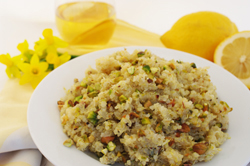 Lemon-Pistachio Quinoa Pilaf Lemon-Pistachio Quinoa Pilaf
Light, fast, and
satisfying! This pilaf cooks with a minimal amount of stovetop energy.
Bring the water to a boil, then turn off the heat and let stand with the
lid on. Quinoa, full of whole-grain goodness, has the highest amount of
protein among grains. The lemon adds brightness, and the pistachios
bring crunch and color. It's versatile as an entrée, or as a side dish.
View and Print
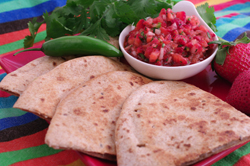 Sweet Onion
Quesadilla Sweet Onion
Quesadilla
with Strawberry-Serrano Salsa
Just in time for Cinco
de Mayo! This quesadilla variation sports fresh flavors and bright
colors. The nutty flavor of the whole-wheat tortillas combined with the
sweet onion is a delicious combination. Use a microwave to wilt the
onion for minimal energy use. The strawberry salsa is a great springtime
variation for these quesadillas.
View and Print
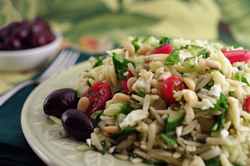 Baby Spinach Orzo Salad Baby Spinach Orzo Salad
Full of veggies, this orzo salad may be served warm or
cold. The orzo is cooked with minimal heat by bringing the pot to a
boil, then standing with a lid on for the remaining cooking time. This
method has the advantage of returning perfectly cooked orzo. Lemon,
fresh herbs, cucumber, and tomatoes finish the salad. We added some
chopped Kalamata olives for extra color contrast and flavor.
View and Print
|
 |
Have fun exploring your
kitchen and cooking habits to see where some extra green might be found!
|
|
Lorraine, Katie, and all of the Staff at Beyond Pots and Pans
|
|
|
|
|